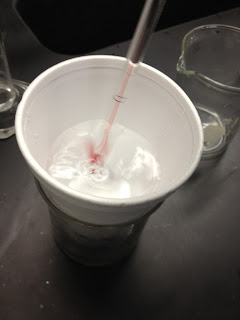(Partners: Erin M., Victoria L., Dan A.)
Observations:

Data:
Sample
|
Mass of empty test tube
|
Mass of test tube plus KNO3
|
Mass of test tube plus KNO3 plus water
|
Saturation Temperature
|
Series 1
|
A
|
8.76 g
|
9.21 g
|
10.26 g
|
50°
|
|
B
|
8.77 g
|
9.47 g
|
10.44 g
|
42°
|
|
C
|
8.82 g
|
10.03 g
|
11.23 g
|
32°
|
Series 2
|
A
|
18.95 g
|
19.31 g
|
20.32 g
|
32°
|
|
B
|
24.04 g
|
25.01 g
|
25.97 g
|
56°
|
|
C
|
18.78 g
|
20.29 g
|
21.16 g
|
60°
|
Post-Lab Calculations and Analysis:
1-2) Series 1: A: 0.45g KNO3 / 1.05g H2O (0.43g)
B: 0.70g KNO3 / 0.97g H2O (0.72g)
C: 1.21g KNO3 / 1.20g H2O (1.01g)
Series 2: A: 0.36g KNO3 / 1.01g H2O (0.36g)
B: 0.97g KNO3 / 0.96g H2O (1.01g)
C: 1.51g KNO3 / 0.87g H2O (1.74g)
3) Series 1: A: 42.86g KNO3/100g H2O
B: 72.16g KNO3/100g H2O
C: 100.83g KNO3/100g H2O
Series 2: A: 35.64g KNO3/100g H2O
B: 101.04g KNO3/100g H2O
C: 173.56g KNO3/100g H2O
4)
5) A. 0g
B. 42.86g
C. n/a
6) A. 32 degrees C
B. 13 degrees C
7)
Saturated- being a mixture that is unable to absorb or dissolve any more of a substance at a given temperature and pressure
Unsaturated- capable of absorbing or dissolving more of something
Supersaturated- containing an amount of something greater than the amount required for saturation by having been cooled from a higher temperature to a temperature below that at which saturation occurs
8) A. supersaturated?
B. unsaturated?
9) The solubility would be higher if water from the test tube evaporated because there would be less water for the KNO3 to dissolve into. The saturation temperature would then be higher.
10) The solubility of the solution would be lower because the temperature was too low.



